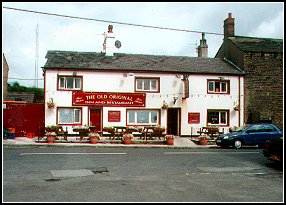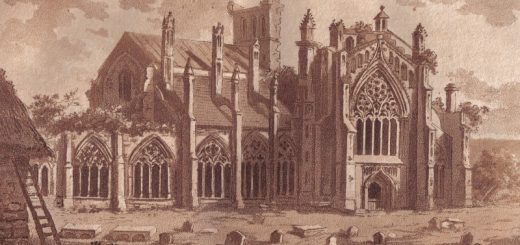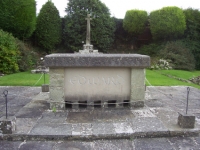Cranbrook, Rose Bay, Australia
In Phantasms of the Living (vol. II) (Frank Podmore, F W H Myers and Edmund Gurney), there is an account of an apparition experienced and identified by multiple witnesses. It is given in a letter by Mr Charles A. W. Lett, a member of the Military and Royal Naval Club, dated December 3rd, 1885, concerning events that took place twelve years earlier.
 ‘On the 5th April, 1873, my wife’s father, Captain Towns, died at his residence, Cranbrook, Rose Bay, near Sydney, N. S. Wales. About six weeks after his death my wife had occasion, one evening about nine o’clock to go to one of the bedrooms, in the house. She was accompanied by a young lady, Miss Berthon, and as they entered the room – the gas was burning all the time – they were amazed to see, reflected as it were on the polished surface of the wardrobe, the image of Captain Towns. It was barely half figure, the head, shoulders, and part of the arms only showing – in fact, it was like an ordinary medallion portrait, but life-size. The face appeared wan and pale, as it did before his death, and he wore a kind of grey flannel jacket, in which he had been accustomed to sleep. Surprised and half-alarmed at what they saw, their first idea was that a portrait had been hung in the room, and that what they saw was its reflection; but there was no picture of the kind.
‘On the 5th April, 1873, my wife’s father, Captain Towns, died at his residence, Cranbrook, Rose Bay, near Sydney, N. S. Wales. About six weeks after his death my wife had occasion, one evening about nine o’clock to go to one of the bedrooms, in the house. She was accompanied by a young lady, Miss Berthon, and as they entered the room – the gas was burning all the time – they were amazed to see, reflected as it were on the polished surface of the wardrobe, the image of Captain Towns. It was barely half figure, the head, shoulders, and part of the arms only showing – in fact, it was like an ordinary medallion portrait, but life-size. The face appeared wan and pale, as it did before his death, and he wore a kind of grey flannel jacket, in which he had been accustomed to sleep. Surprised and half-alarmed at what they saw, their first idea was that a portrait had been hung in the room, and that what they saw was its reflection; but there was no picture of the kind.
Whilst they were looking and wondering, my wife’s sister, Miss Towns, came into the room, and before either of the others had time to speak she exclaimed, ‘Good gracious! Do you see Papa?’ One of the housemaids happened to be passing downstairs at the moment, and she was called in, and asked if she saw anything, and her reply was, ‘Oh, miss! the master.’ Graham Captain Towns’ old body servant – was then sent for, and he also immediately exclaimed, ‘Oh, Lord save us! Mrs Lett, it’s the Captain!’ The butler was called, and then Mrs Crane, my wife’s nurse, and they both said what they saw. Finally, Mrs Towns was sent for, and, seeing the apparition, she advanced towards it with her arm extended as if to touch it, and as she passed her hand over the panel of the wardrobe the figure gradually faded away, and never again appeared, though the room was regularly occupied for a long time after.
These are the simple facts of the case, and they admit of no doubt; no kind of intimation was given to any of the witnesses; the same question was put to each one as they came into the room, and the reply was given without hesitation by each. It was by the merest accident that I did not see the apparition. I was in the house at the time, but did not hear when I was called.’
C. A. W. LETT.
We, the undersigned, having read the above statement, certify that it is strictly accurate, as we both were witnesses of the apparition.
SARA LETT
SIBBIE SMYTH (nee TOWNS).
Edmund Gurney (March 23, 1847 – June 23, 1888), one of the co-founders of the Society for Psychical Research (Established 1882) commented about the case: ‘Mrs Lett assures me that neither she nor her sister ever experienced a hallucination of the senses on any other occasion. She is positive that the recognition of the appearance on the part of each of the later witnesses was independent, and not due to any suggestion from the persons already in the room.’
Cranbrook Before Captain Towns
Cranbrook is on the southern side of New South Head Road and originally part of the Cooper Estate. Built in the Victorian Free Classical style by Robert Tooth in 1850, Edwin Tooth acquired the property in 1856. It is named after the district in Kent, England from which his family came. When Edwin died in 1858 it passed to his brother Frederick who sold it to Captain Towns in 1864.
Captain Towns
Captain Robert Towns was a sea captain, ship-owner, merchant and developer. Born in Long Horsey, Northumberland, England, Towns studied navigation whilst apprenticed on a collier. He became master of his first vessel at the age of nineteen, a brig in the Mediterranean. He first visited Sydney in 1827 and made several voyages there until 1843. In 1843 he settled in Sydney, buying some ships and setting up his Headquarters at Jones’ wharf, Millers Point. He was one of the first people to import natives from the Solomon Islands( Kanakas) into Queensland to work in his cotton fields, enabling him to be one the first people to grow cotton on a large scale in Australia.Townsville founded in 1864 was also named after him.
Cranbrook After Towns
James White (1828-1890) a famous racehorse owner and breeder bought Cranbrook, from the estate of Captain Towns shortly after his death. White then commissioned John Horbury Hunt to add extensions before moving his extensive art collection into the property, including Italian, German and English pieces. In 1890 White retired from the Australian Jockey Club and sold his race horses. On 13 July of that year he died at Cranbrook of heart disease, leaving the house to his wife. In 1900 it was bought by the New South Wales Government as a State Government House and was home to the NSW Governor. In 1917 it was sold again and became Cranbrook School for boys in 1918 and remains so to this day.




Although he did not take a
Although he did not take a leading part in politics, Towns had been a member of the legislative council from 1856. Following his death The Sydney Morning Herald, April 17, 1873 had the following to say about a meeting of the New South Wales Parliament Legislative Council the day previously where the members paid their respect to him. ‘Mr. Docker announced that since the last sitting of the House the Hon.Robert Towns was deceased, and that the President had directed the name of that gentleman to be struck off the list of members. Mr. Samuel, in consequence of this announcement, moved, that the House, as a mark of respect to the deceased, do now adjourn it to tomorrow (Thursday).….. Mr. Deas Thomson had the following to say ‘All knew that Captain Towns for a great number of years, had been connected with New South Wales as one of its most enterprising colonists-that -he had been largely engaged in the shipping-interest, and that his services in the House were, always extremely valuable; in reference to mercantile and marine questions…….Captain Towns had very extensive engagements in squatting and other, enterprises’. He was, in fact one of our most enterprising colonists, and the compliment now proposed was fully duo to his memory. Mr. A, Campbell said the motion had his thorough concurrence, and he wished to make a few remarks on the occasion, because he believed he had known Captain Towns as long as any member of the House and more intimately in his business relations. In paying this, tribute to his memory, he might say that, as far as his knowledge of Captain Towns’ character was concerned, no man who had ever occupied a seat in that House, was, more entitled such a mark of respect to his memory, I for upwards of thirty years had known Captain Towns in his business relations, and indeed had engaged in large and complicated transactions , with him for the greater, part, of that period. It was only right to- state that no one could point to a more truly British merchant than the hon. member whoso memory they proposed to honor’
Here is a piture I found of
Here is a piture I found of Cranbrook circa 1860 when Towns would have been the owner.
[img_assist|nid=1667|title=|desc=|link=none|align=center|width=250|height=161]